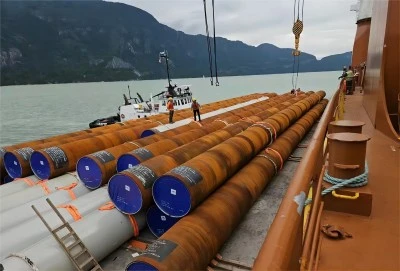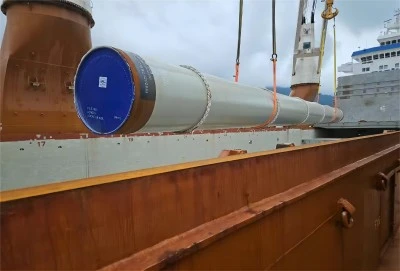The main difference between ASTM A53 and ASTM A252 steel pipes lies in their intended applications and specific properties. ASTM A53 pipes are primarily used for conveying fluids under pressure in various industries, while A252 steel pipes are designed for foundation piling and other load-bearing structural applications. A252 pipes typically have higher strength requirements and are available in larger diameters compared to A53 pipes. Understanding these distinctions is crucial for engineers and project managers in selecting the right pipe for their specific needs in oil and gas, water supply, and construction projects.
|
|
|
Key Properties: ASTM A53 vs. A252 Pipes
Chemical Composition and Manufacturing ProcessASTM A53 and A252 pipes differ significantly in their chemical composition and manufacturing processes. A53 pipes are made from carbon steel and come in three grades: A, B, and C. Grade B is the most common, offering a balance of strength and weldability. The manufacturing process for A53 pipes involves either seamless or welded construction, with options for hot-finished or cold-worked pipes.
On the other hand, ASTM A252 steel pipes are typically produced using a welding process and are available in three grades: 1, 2, and 3. These grades correspond to increasing yield strength requirements. The chemical composition of A252 pipes allows for higher carbon content, which contributes to their increased strength and durability.
Strength and Tolerance Specifications
When it comes to strength, ASTM A252 pipes generally outperform A53 pipes. A252 Grade 3 pipes, for instance, have a minimum yield strength of 45,000 psi, while A53 Grade B pipes have a minimum yield strength of 35,000 psi. This higher strength makes A252 pipes more suitable for load-bearing applications in foundation piling and structural support.
Tolerance specifications also differ between these two types of pipes. A53 pipes have tighter tolerances on dimensions and straightness, which is crucial for pressure applications. A252 pipes, while still having specific tolerance requirements, are generally more forgiving in this aspect due to their primary use in structural applications.
Seamless vs. Welded: A53 and A252 Compared
ASTM A53 pipes are available in both seamless and welded varieties. Seamless A53 pipes are often preferred for high-pressure applications due to their uniform strength around the circumference. Welded A53 pipes, while slightly less expensive, are still widely used and meet the necessary standards for many applications.
In contrast, ASTM A252 pipes are primarily produced as welded pipes. The welding process for A252 pipes is highly controlled to ensure the weld seam meets the required strength specifications. This is particularly important given the structural nature of A252 applications, where the pipe's integrity under load is paramount.
Applications: When to Choose A53 or A252
A53: Pressure Applications and General UseASTM A53 pipes excel in pressure applications across various industries. In oil and gas transportation, these pipes are commonly used for gathering lines and distribution systems. Their pressure-bearing capabilities make them ideal for conveying fluids and gases over long distances.
In water supply systems, A53 pipes are often the go-to choice for municipal water distribution networks. Their corrosion resistance and ability to withstand varying water pressures ensure reliable service over extended periods. Industrial manufacturing facilities also rely on A53 pipes for process piping, compressed air systems, and fire protection networks.
A252: Foundation and Structural Support
ASTM A252 steel pipes shine in applications requiring significant structural support. In bridge construction, these pipes are used for foundation piling, providing a stable base for bridge piers and abutments. The higher strength of A252 pipes allows them to withstand the substantial loads associated with large structures.
Offshore platform construction is another area where A252 pipes prove invaluable. They are used for creating sturdy foundations in marine environments, capable of withstanding the harsh conditions and dynamic loads encountered at sea. In building construction, A252 pipes are employed for deep foundation systems, particularly in areas with challenging soil conditions.
Industry-Specific Pipe Selection Guidelines
Selecting between A53 and A252 pipes depends on the specific industry and application requirements. In the oil and gas sector, A53 pipes are typically chosen for pipeline networks, while A252 pipes might be used for structural components of drilling platforms. Water supply projects generally lean towards A53 pipes for distribution systems, but may utilize A252 pipes for large-diameter culverts or tunnel linings.
For construction projects, the choice often comes down to the specific structural demands. A252 pipes are preferred for deep foundations and load-bearing elements, while A53 pipes might be used for non-structural or low-pressure applications within the building.
Cost-Benefit Analysis: A53 and A252 Comparison
Price Points: A53 vs. A252 in Global MarketsThe cost of ASTM A53 and A252 pipes can vary significantly depending on global market conditions, raw material prices, and specific project requirements. Generally, A53 pipes tend to be more economical due to their wider availability and more standardized production processes. This makes them a cost-effective choice for many general-purpose and pressure applications.
ASTM A252 steel pipes, on the other hand, often command a higher price point. This is primarily due to their higher strength requirements and the specialized manufacturing processes involved. The larger diameters available in A252 pipes also contribute to their higher cost. However, in structural applications where their superior strength is necessary, the additional cost is often justified by the performance benefits.
Performance vs. Investment: Long-term Considerations
When evaluating the long-term value of A53 versus A252 pipes, it's crucial to consider the total lifecycle cost rather than just the initial investment. A53 pipes, while less expensive upfront, may require more frequent replacement or maintenance in high-stress applications. This could lead to higher long-term costs in certain scenarios.
A252 pipes, despite their higher initial cost, often provide better long-term value in structural applications. Their superior strength and durability can result in reduced maintenance needs and longer service life, particularly in challenging environments like marine settings or deep foundations. This longevity can offset the higher upfront costs over time.
Sustainability and Environmental Impact Factors
Both A53 and A252 pipes have environmental considerations that should be factored into the decision-making process. A53 pipes, being more commonly used in fluid transportation, have a direct impact on energy efficiency in pipeline systems. Properly selected and installed A53 pipes can minimize leaks and reduce energy consumption in pumping operations.
A252 pipes, often used in large-scale construction projects, play a role in the overall sustainability of structures. Their durability contributes to longer-lasting infrastructure, potentially reducing the need for frequent replacements and the associated environmental impacts of construction activities. Additionally, the use of A252 pipes in deep foundations can sometimes reduce the overall material requirements for a project, leading to a lower carbon footprint.
The choice between ASTM A53 and ASTM A252 pipes depends on the specific requirements of your project. A53 pipes excel in pressure applications and general use, making them ideal for fluid transportation in various industries. A252 steel pipes, with their superior strength, are the go-to choice for structural support and foundation work. Consider factors like application needs, long-term performance, and environmental impact when making your selection. For expert guidance and high-quality pipes that meet international standards, consulting with a reputable supplier can ensure you make the best choice for your project's success.
Buy ASTM A53 and A252 Steel Pipes
For top-quality ASTM A53 and A252 steel pipes, look no further than Hebei Longma Group. Our advanced production equipment, imported from Germany and enhanced with our own innovations, ensures precision manufacturing. With a professional team of over 300 employees, including 60+ technical experts, we guarantee expertise in every pipe we produce. Our comprehensive testing facilities, including ultrasonic flaw detectors and X-ray systems, ensure the highest quality standards. We offer fast delivery. Our complete certification, including API 5L and ISO standards, provides peace of mind for your projects. Thanks to our efficient production model and strong supplier relationships, we offer competitive pricing without compromising on quality. For all your ASTM A252 steel pipe needs, contact us at info@longma-group.com.














